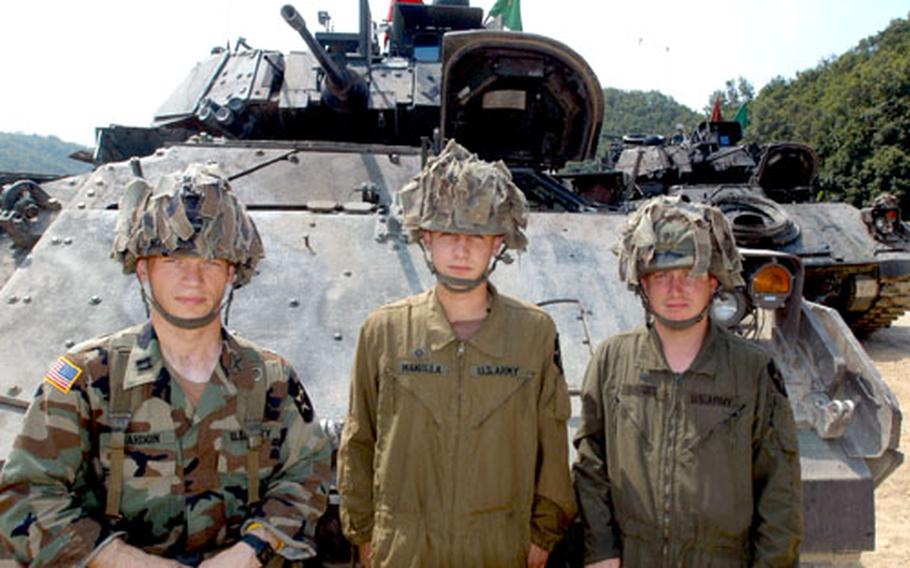
From left: Capt. Mike Reardon, 32, of San Antonio, Spc. Mark Manilla, 21, of Morgantown, W.Va., and Spc. Joshua Harris, 29, of Campton, Ky., all with the 2nd Battalion, 9th Infantry Regiment’s Company B, pose Wednesday with their Bradley Fighting Vehicle at Rodriguez Range, South Korea. (Seth Robson / Stars and Stripes)
RODRIGUEZ RANGE, South Korea — Adding M1A1 Abrams Main Battle Tanks and engineers to 2nd Battalion, 9th Infantry Regiment’s Bradley Fighting Vehicles gives the unit the strength to defend against an entire enemy brigade, commander Lt. Col. Ryan Kuhn said.
His unit added the tanks, formerly assigned to 1st Battalion, 72nd Armored Regiment, and the engineers, from the recently inactivated 2nd Engineer Battalion, as part of the 2nd Infantry Division’s transformation over the past six months.
Kuhn said last week that the tanks, Bradleys, engineers and infantrymen equipped with Javelin anti-tank weapons made the unit, which is training at Rodriguez Range until the end of the month, a force to be reckoned with.
“The tanks have increased our firepower capability and lethality. What it really does is puts together a combined arms team that trains together all the time and gives the brigade and division commander a lethal capability we did not have before,” he said. “Before [transformation] we had to task organize. We would train together as a ad hoc organization.”
The unit’s new configuration made Kuhn “confident we could destroy anything up to a brigade or regimental-sized organization if we were in a defensive situation.”
His unit is 2nd ID’s oldest and his soldiers have passed their history and traditions to the newly added soldiers, he said. He said 2-9 also has incorporated the prestigious lineage of the tank and engineer companies, he said.
The training at Rodriguez Range this month, preparation for platoon-level training in October, is designed to give crews and individual soldiers confidence operating their weapons systems, he said.
At the range Wednesday morning, 2-9 Company B commander Capt. Mike Reardon, 32, of San Antonio, sweated in the blistering heat while a pair of Bradleys moved up to their firing positions and crews scanned for targets.
“Right now we are doing crew practice. All the work done prior to this, like individual training on the weapons and maintaining the vehicles, is what nobody sees,” he said.
The first part of the sustainment gunnery practice, for both tankers and Bradley crews, involves a dry run. Crews scan for targets on the range and then go through their fire commands. After that crews do live-fire runs, then practice moving and stationary engagements, day and night shooting and nuclear, biological and chemical warfare drills, he said.
“Normally you are just making sure the weapons systems is working, so when you fire live rounds is when it pays off,” said Company B Bradley gunner Spc. Joshua Harris, 29, of Campton Ky.